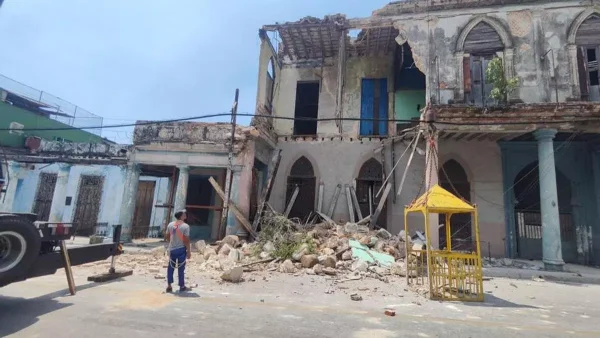A Once Elegant 19th Century Home Collapses in Havana

Despite its deterioration, some of the house’s grandeur can still be appreciated.
By Juan Diego Rodríguez (14ymedio)
HAVANA TIMES – The historic Casa de doña Luz Godínez de Diago, as marked on the maps, a 19th-century building in Havana, no longer exists as such. This Wednesday, the building, numbered 1360 on Calzada del Cerro, suffered a partial collapse of its facade and roof.
“It is actually a relief because the building has been in danger of collapsing for years, and the fear of all of us living nearby was that it would end in tragedy,” a neighbor of the two-story mansion told 14ymedio. The demolition work has forced a power cut in the area.
“Since yesterday, we saw some sand falling, and shortly after, we heard the crash,” detailed a woman standing in front of the mansion, which once belonged to one of the aristocratic families of Havana who sought refuge in the Cerro neighborhood two centuries ago to leave behind the inner city, its noise, and foul smells. The mansion has gone through various uses in recent decades, both private and state.
“In the front part, next to the facade, no one lives, but there are several families behind,” the woman explained to this newspaper. A demolition team, with a cabin for at least two workers to hit the remaining walls with sledgehammers, was in front of the building located between Patria and Saravia streets this Wednesday afternoon. “They are going to have to hurry because it looks like a heavy downpour is coming,” commented another nearby resident.
The huge rubble from the collapse occupies part of the street leading to the famous Tejas corner, a commercial node that has also fallen into disrepair, then continues to Monte Street and the Capitol of Havana. The fragments of walls and columns are impressively large. “It’s incredible that they didn’t crush a car,” added an onlooker watching the operations from behind the yellow tape closing off the street.
Despite the deterioration and the hole in the facade exposing part of the building’s interior, some of its grandeur can still be appreciated. A wide portal with slender columns supports an upper floor with pointed arches and a balcony spanning the entire width of the mansion, which long ago lost the ornate grille that allowed one to lean on the terrace and enjoy the breeze. Below, another arch with Mudéjar inspiration still retains some of its grandeur.
The house right next to number 1360, smaller and neoclassical in style, has its portal shored up with wooden beams and has suffered some damage following the collapse of part of the nearby building. On the street, a shrub mixes with the rubble because it was dragged from a crack where it had grown for years near the roof of the old Godínez de Diago mansion.
In the neighborhood, electricity had to be cut to carry out the demolition work due to the proximity of the wiring to the building’s facade. The blackout has particularly annoyed residents in a Havana area that has been suffering from water supply problems for days and hoped to fill their tanks and containers this afternoon if the service is restored. Without electricity, the motors that draw water from the cisterns cannot even turn on.
Calzada del Cerro, one of the most important roads in the Cuban capital, connects parts of the Plaza de la Revolución and Cerro municipalities with Centro Habana and Old Havana. It is a traditional route for urban buses and collective taxis, especially those that travel between the Parque de la Fraternidad and the areas of La Lisa and Marianao. Its closure this Wednesday has forced traffic to be diverted through narrower parallel streets badly affected by asphalt deterioration.
Calzada del Cerro has also been one of the avenues most affected by the passage of time, state neglect, and few investments in recent decades. Without the attractions of the historic center of Havana or the more modern El Vedado, the street has numerous tenements where overcrowding and improvised divisions have further deteriorated its infrastructure.
What was once a promenade with wide portals, countless vibrant shops, and a great social life has languished into a route many Havanans avoid due to the danger of a balcony collapse, sewage water accumulating in its corners, mountains of garbage piling up in its alleys, and the insecurity that has taken over its surroundings, especially at night.
The heavy rains of recent days have caused dozens of collapses in Havana, resulting in one death and several injuries. Last Friday, an official source, who preferred to remain anonymous, informed this newspaper that in the Cuban capital, the heavy rains had caused 19 partial collapses, but in the following days, the number continued to grow.
On Sunday night, one of the capital’s most emblematic buildings, the Manzanares Building, suffered an interior collapse. Around 9:20 pm, a mezzanine collapsed, dragging along the bathrooms and kitchens of the lower floors at number 912 on San Francisco Street, one of the entrances to the apartment complex.





